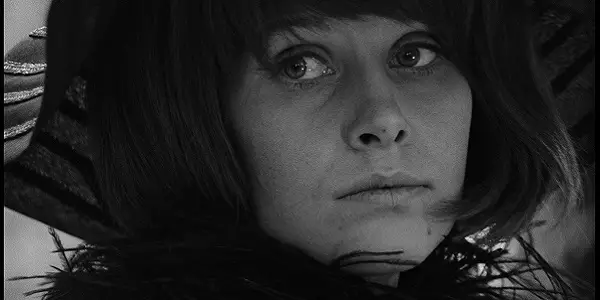How much can the remnants of one individual’s life tell us about the world in which they lived? This is the question at the heart of Time of Roses, an uber-stylish sci-fi thriller from Finnish director Risto Jarva soon to be available in a new restoration from Deaf Crocodile Films and the Risto Jarva Association. Originally released in 1969, the film takes place in a dystopian 2012 — one full of inflatable furniture, silent discos, and sleek architecture — as a historian of late 20th-century culture turns the tragic life and death of an erotic model into a TV docudrama.
Doppelgänger Drama
According to the records kept by the Institute of History, massive global unrest in the late 20th century has since given way to progress and peace. Raimo Lappalainen (Arto Tuominen), a historian who makes documentaries for television, has decided that the focus of his next project will be the brief life of Saara Turunen (Ritva Vepsä), who died in a traffic accident in the 1970s. By exploring the life and death of Saara, a drugstore salesgirl who did nude modeling to make ends meet and was entangled in a scandal involving money for an abortion, Raimo hopes to provide his audience with an accurate portrait of what society was like during that time period.

When Raimo meets Kisse (also Vepsä), a vivacious young nuclear engineer who is the spitting image of Saara, he convinces her to recreate scenes from Saara’s life — up to and including her tragic demise — on camera for his film. Naturally, he falls in love with her; little does he know that Kisse is secretly conspiring with her colleagues at the nuclear plant to use Raimo and his television connections to raise awareness of their strike, which has been suppressed by the mainstream media.
In a world where class differences are supposed to have been abolished, a strike would be unwelcome evidence that such conflicts and concepts have not been completely confined to the past. This becomes increasingly clear as Raimo continues researching and shooting his film and the boundaries between past and present — and Saara and Kisse — become blurrier and blurrier.
Back to the Future
Time of Roses mixes Mod style with some surprisingly prescient technological advancements to create one of the most aesthetically interesting retro-future worlds I have ever seen. This is a world where house parties involve everyone lying around in semi-orgiastic splendor, enthusiastically moving their hands to the music as though they’re sculpting shapes in the empty air; where nuclear engineers spend their lunch breaks playing touchy-feely games of co-ed handball while wearing cute striped rompers; where the spidery mascara and cropped hair worn by Twiggy are still in mode nearly fifty years after she made them famous.
There is also a great deal of the aforementioned inflatable furniture in Time of Roses, which is used to incredible visual effect in two separate scenes: the first an almost kaleidoscopic love scene, shot through the folds and creases of a plastic couch, that turns the human bodies involved into an abstract tangle of distorted limbs, the second a moment of drunken self-pity during a house party, in which the slowly deflating couch serves as a visual representation of its occupant’s ego. Fortunately, the new restoration of Time of Roses was created from a scan of the original 35mm camera negative, preserving all of the wonderful grain and contrast of Antti Peippo’s cinematography and emphasizing the vintage vibes of this futuristic vision.
The narrative does, at some points, sag under the weight of all this aesthetic, but even in the film’s slowest moments, it’s hard to not be fascinated. In the Vertigo-esque dual roles of Saara and Kisse, Vepsä is appropriately enigmatic, letting on just enough to make you (and Raimo) want to know more about what’s behind that beautiful facade. Yet it’s Raimo’s inability to see beyond the uncanny physical resemblance—where the real similarities between Saara and Kisse lie—that threatens to doom the latter to the same tragic fate as her deceased doppelgänger. Despite his ongoing obsession with the past, Raimo is incapable of recognizing the symptoms of that same societal rot in the present until it’s far too late, and no amount of eloquent docudrama narration claiming “all is well” can make it so.
Conclusion
Intriguing despite its imperfections, Time of Roses is a journey through time and space worth taking.
The new 4K restoration of Time of Roses is available to pre-order on Blu-ray from Vinegar Syndrome.
Watch Time of Roses
Does content like this matter to you?
Become a Member and support film journalism. Unlock access to all of Film Inquiry`s great articles. Join a community of like-minded readers who are passionate about cinema - get access to our private members Network, give back to independent filmmakers, and more.